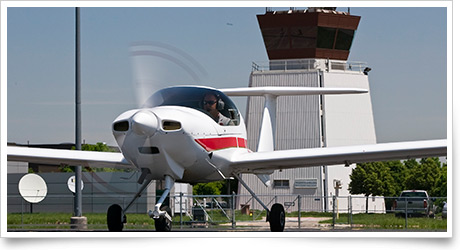training tipsReady for prime time?
It means there’s no reason to limit your destinations to outlying airports where your comfort level is already pretty high. It’s time to plan a trip to a reasonably busy towered airport at a time when the activity level will let you experience arrival, departure, and some coordination with air traffic control under real-world conditions.
Do your destination homework and there won’t be any mystery. Take, for example, Asheville Regional Airport in mountainous western North Carolina. It’s the nucleus of a Class C airspace area; note the nonstandard airspace configuration and the nearby high terrain.
Checking out its listing in AOPA Airports produces an airport diagram, and reveals that there are several approach and departure procedures for those flights operating under instrument flight rules that you will hear on the radio. The listing shows that there are about 200 aircraft based at the airport, and that the facility has thousands of flight operations per year—important knowledge to have before heading to Asheville.
The sectional chart reminds you that frequencies for contacting radar approach control are assigned by sector. The airport/facility directory elaborates: "APP/DEP CON 124.65 (160º–339º) 125.8 (340º–159º) (1130–0400Z‡)." At other times Atlanta Center provides the service. Which sector will you be in when you make your initial call?
In addition to high traffic volume, many towered airports have peak periods not unlike morning and evening highway rush hours. A call to the destination fixed-base operator could fill you in on what's customary.
Even with so much activity, Asheville’s control tower is not “24/7.” When it is closed, the airspace defaults to Class G ( other airports in Class C airspace default to Class E). The tower should be open when you arrive in late morning, so you must establish two-way communications—from your altitude-encoding transponder-equipped trainer—before entering Class C airspace.
A final detail: Daylight saving time took effect March 10, so remember to adjust your conversion to or from Coordinated Universal Time appropriately. training productsLearn radio communications with appSporty’s VFR Communications iPhone/iPad Aviation App helps student pilots sound like seasoned pros. The app uses a visual menu system to break down VFR communications into eight subject areas and 23 individual video segments. It contains more than 60 minutes of engaging 3-D animations, in-flight video, and real-world communication scenarios. The app costs $24.99. Flight maneuvers guide available as e-bookAircraftSpruce.com has made available an e-book, Private Pilot Flight Maneuvers . The e-book helps in the explanation, visualization, and execution of the flight maneuvers required for the private pilot practical test. The e-book costs $16.95. Note: Products listed have not been evaluated by ePilot editors unless otherwise noted. AOPA assumes no responsibility for products or services listed or for claims or actions by manufacturers or vendors. final examQuestion: I’ve always wondered why the airport beacon is on sometimes during the day when the weather is bad. Why is that? Answer: The operation of the airport beacon during the daylight hours often indicates that the ground visibility is less than three statute miles and/or the ceiling is less than 1,000 feet. However, pilots should not rely only on the airport beacon to indicate if weather conditions are below minimums for VFR flight, but should check the weather themselves at the base airport, en route, and at the destination. Got a question for our technical services staff? Email [email protected] or call the Pilot Information Center, 800/872-2672. Don’t forget the online archive of “Final Exam” questions and answers, searchable by keyword or topic. |
 Your flight instructor has told you that you are “ready for prime time.” You heard the CFI say that once before, on the day of your first solo. What does it mean now as you work through the solo cross-country phase of training?
Your flight instructor has told you that you are “ready for prime time.” You heard the CFI say that once before, on the day of your first solo. What does it mean now as you work through the solo cross-country phase of training?

